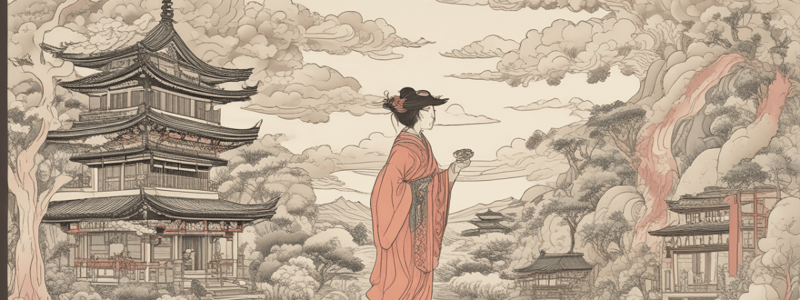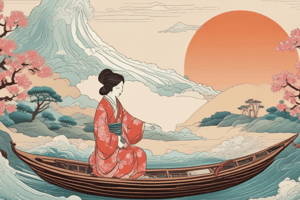Podcast
Questions and Answers
What was the main focus of the second part of this module?
What was the main focus of the second part of this module?
- The development of Western arts in Japan
- The modernization of Japan during the Meiji Restoration
- The Japanese Folk Crafts movement, known as Mingei (correct)
- The decline of Japanese arts and crafts in the West
What was the result of the top-down effort to modernize Japan during the Meiji Restoration?
What was the result of the top-down effort to modernize Japan during the Meiji Restoration?
- The elevation of craft above painting and sculpture
- The decline of Western models in Japan
- The adoption of a new system of government and legal frameworks (correct)
- The adoption of traditional Japanese arts and crafts
What was the initial public preference in the art market during the Meiji Restoration?
What was the initial public preference in the art market during the Meiji Restoration?
- Individual craftspeople educated in fine arts universities
- Japanese Folk Crafts movement
- Western models and fine arts (correct)
- Traditional Japanese arts and crafts
Why did interest in Japanese arts and crafts decline in the West?
Why did interest in Japanese arts and crafts decline in the West?
What characterized the approach of craft during the Meiji Restoration?
What characterized the approach of craft during the Meiji Restoration?
What is the abbreviation of minshuteki kogei?
What is the abbreviation of minshuteki kogei?
When was the Mingei movement officially founded?
When was the Mingei movement officially founded?
What was the main factor that led to the wide consumption of folk crafts by the urban middle classes in Japan?
What was the main factor that led to the wide consumption of folk crafts by the urban middle classes in Japan?
Who founded the Japan Folk Craft Museum in Meguro, Tokyo?
Who founded the Japan Folk Craft Museum in Meguro, Tokyo?
What prompted the reconstruction of Tokyo into a modern city?
What prompted the reconstruction of Tokyo into a modern city?
What was the name of the title given to people who hold skills and knowledge that are seen as historically and culturally relevant in Japan?
What was the name of the title given to people who hold skills and knowledge that are seen as historically and culturally relevant in Japan?
What type of glaze was used in the production of the flower jar with a floral design shown in Slide 16?
What type of glaze was used in the production of the flower jar with a floral design shown in Slide 16?
Who pioneered the development of folklore studies in Japan?
Who pioneered the development of folklore studies in Japan?
Who was inspired by Morris and Ruskin's ideas but rejected any Western influence?
Who was inspired by Morris and Ruskin's ideas but rejected any Western influence?
What was the focus of the tea ceremony, known as wabicha?
What was the focus of the tea ceremony, known as wabicha?
What was the result of the archaeological excavations in Japan during the Taisho era?
What was the result of the archaeological excavations in Japan during the Taisho era?
What was the name of the process used in the production of the greyish part of the piece shown in Slide 17?
What was the name of the process used in the production of the greyish part of the piece shown in Slide 17?
What was the reason for the wide consumption of folk crafts by the urban middle classes in Japan?
What was the reason for the wide consumption of folk crafts by the urban middle classes in Japan?
What was the focus of the Momoyama revival movement?
What was the focus of the Momoyama revival movement?
What was the main goal of the Mingei movement?
What was the main goal of the Mingei movement?
What was the name of the artist-craftsman who rediscovered the Shino glaze technique?
What was the name of the artist-craftsman who rediscovered the Shino glaze technique?
Where was the Folk Museum founded by Yanagi Soetsu in 1924?
Where was the Folk Museum founded by Yanagi Soetsu in 1924?
What was the characteristic of medieval aesthetics in Japan?
What was the characteristic of medieval aesthetics in Japan?
What was the result of the expansion of an educated middle-class in Japan during the Taisho era?
What was the result of the expansion of an educated middle-class in Japan during the Taisho era?
What was the name of the famous tea school founded by Sen no Rikyu?
What was the name of the famous tea school founded by Sen no Rikyu?
What was the trend in Japan during the 1920s, following the devastating Kanto earthquake?
What was the trend in Japan during the 1920s, following the devastating Kanto earthquake?
What technique was used to create the complex patterns on the Edo Sarasa fabrics?
What technique was used to create the complex patterns on the Edo Sarasa fabrics?
What is the core concept of Pure Land Buddhism that influenced Yanagi's aesthetic philosophy?
What is the core concept of Pure Land Buddhism that influenced Yanagi's aesthetic philosophy?
What did Yanagi believe was the beauty of folk crafts?
What did Yanagi believe was the beauty of folk crafts?
What did Yanagi reject in his aesthetic philosophy?
What did Yanagi reject in his aesthetic philosophy?
What is a characteristic of the Mingei movement, according to some scholars?
What is a characteristic of the Mingei movement, according to some scholars?
What is the multifaceted nature of the Mingei movement rooted in?
What is the multifaceted nature of the Mingei movement rooted in?
Who is the creator of the gourd-shaped jar that reinterprets the Edo Sarasa pattern?
Who is the creator of the gourd-shaped jar that reinterprets the Edo Sarasa pattern?
What was the main irony of the Mingei movement?
What was the main irony of the Mingei movement?
What was Bernard Leach responsible for reviving in medieval British pottery?
What was Bernard Leach responsible for reviving in medieval British pottery?
What was the primary characteristic of Mingei movement, according to the text?
What was the primary characteristic of Mingei movement, according to the text?
Why did Yanagi Soetsu criticize the works of Hamada and other artist-potters?
Why did Yanagi Soetsu criticize the works of Hamada and other artist-potters?
According to Yanagi, what is the most important condition for an object to be considered folk craft?
According to Yanagi, what is the most important condition for an object to be considered folk craft?
What is the primary difference between folk crafts and individual or artistic crafts, according to Yanagi?
What is the primary difference between folk crafts and individual or artistic crafts, according to Yanagi?
What is the main aspect of Mingei that represents an authentic mode of living and making?
What is the main aspect of Mingei that represents an authentic mode of living and making?
Who introduced the British technique of slipware to Japan?
Who introduced the British technique of slipware to Japan?
What was the primary reason why Yanagi Soetsu distinguished folk crafts from aristocratic, industrial, and artistic crafts?
What was the primary reason why Yanagi Soetsu distinguished folk crafts from aristocratic, industrial, and artistic crafts?
Study Notes
The Mingei Movement in Japan
- The Mingei movement, also known as the Japanese Folk Crafts movement, emerged in the 1920s and 1930s in Japan.
- It was initiated by artists, craftspeople, and intellectuals during the Taisho era, with a focus on promoting traditional Japanese crafts and aesthetics.
Context: Modernization and Westernization in Japan
- During the Meiji Restoration, Japan underwent rapid modernization and Westernization, leading to the adoption of Western models in government, law, military practices, and arts.
- Initially, public preferences and the art market favored Western models, elevating painting and sculpture above craft.
- Craft eventually gained acceptance, but was associated with individual artists or craftspeople educated in fine arts universities, mirroring the image of the solitary artist working in a studio.
Decline of Western Interest and Rediscovery of Japanese Arts and Crafts
- In the late 19th and early 20th centuries, interest in Japanese arts and crafts declined in the West.
- Western artists and craftspeople successfully incorporated Japanese techniques and aesthetics into their own work.
- The 1920s saw a rediscovery of Japanese styles by artist-potters, leading to their widespread consumption by the growing educated middle classes of urban Japan.
Founding of the Mingei Movement
- The Mingei movement was officially founded in 1926 at Mount Koya, a famous site of Buddhist pilgrimage in Wakayama Prefecture, by philosopher and art critic Yanagi Soetsu, and artist-craftsmen Shoji Hamada and Kawai Kanjiro.
- Yanagi Soetsu was initially interested in Western art and modernism, but later became interested in folk crafts after receiving a pottery jar from Korea.
Organization and Promotion of Mingei
- The Mingei movement had three main branches: the Takumi shop, the Japanese folk crafts movement, and two monthly magazines, Kogei and Gekkan Mingei.
- These branches promoted the work of craftspeople, created knowledge and sales networks, and allowed them to continue their traditional craftwork following pre-modern traditions.
Key Figures and Craft Artists
- Yanagi Soetsu, Shoji Hamada, and Kawai Kanjiro were key figures in the Mingei movement.
- Hamada and Kawai were later recognized as Living National Treasures in Japan, illustrating the official endorsement of the Mingei movement.
- Other notable craft artists involved in the movement included Kanjiro Kawai, Shoji Hamada, and Arakawa Toyozo.
Characteristics and Aesthetic Philosophy of Mingei
- The Mingei movement emphasized simplicity, imperfection, and roughness, reflecting the concept of wabi-sabi.
- It also hybridized ideas from the British Crafts movement with the aesthetics of the medieval tea ceremony and Buddhist principles, particularly the concept of tariki or other-power.
- Yanagi believed that the beauty of folk crafts lay in the lack of self-consciousness or ego by common craftspeople, representing the power of nature and inherited traditions.
Criticism and Contradictions of the Mingei Movement
- The movement was criticized for its top-down nature, led by urban intellectuals and university-educated artist-craftspeople, which stifled innovation and the natural change of traditional forms.
- The movement's emphasis on traditional techniques and styles also presented a dilemma for craftspeople, who had to navigate the changing demands of a market economy while striving to uphold traditional forms.
- Yanagi's rigid standards and aesthetic philosophy were also seen as contradictory to the movement's core principles of democracy and folk craftsmanship.
Studying That Suits You
Use AI to generate personalized quizzes and flashcards to suit your learning preferences.
Description
Explore the development of crafts in modern Japan, focusing on the influential Mingei movement, its context, key figures, influences, and principles. Learn about the democratic crafts movement initiated by artists, craftspeople, and intellectuals during the Taisho era.

